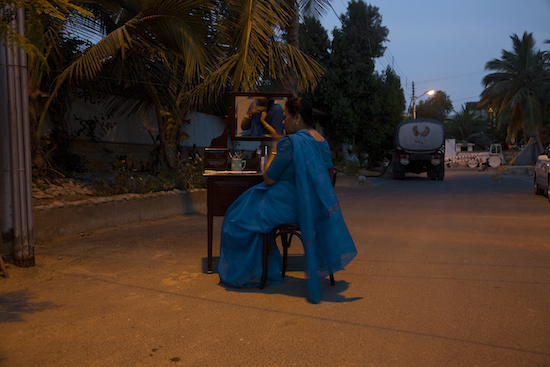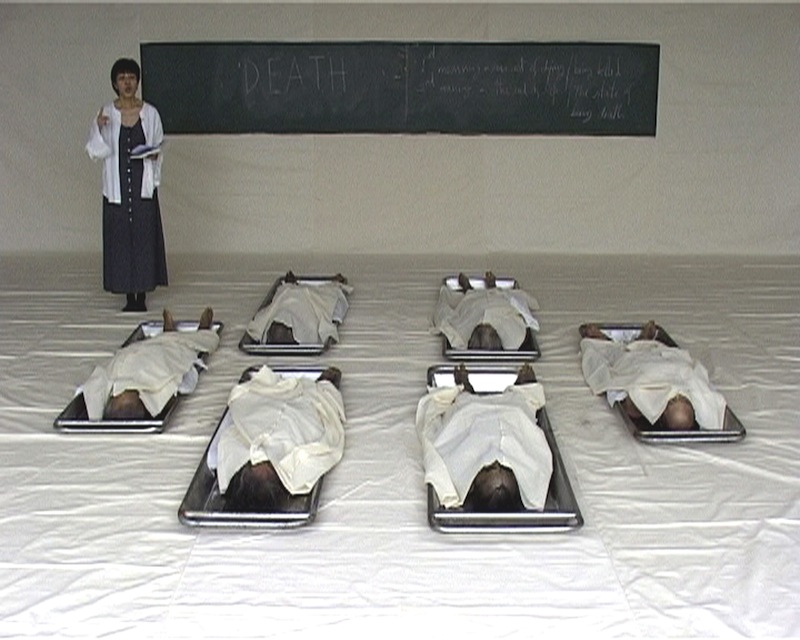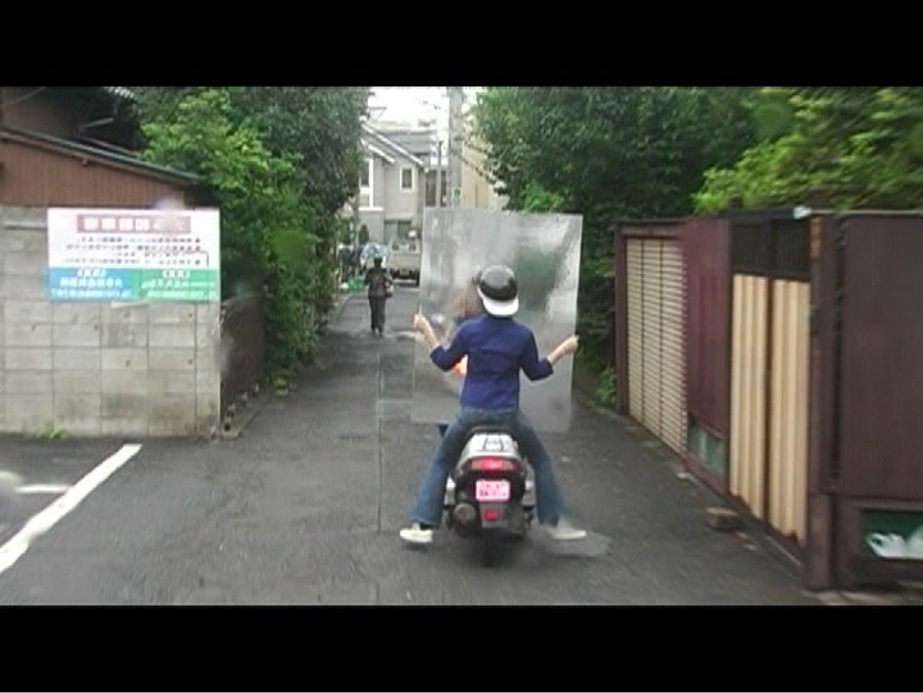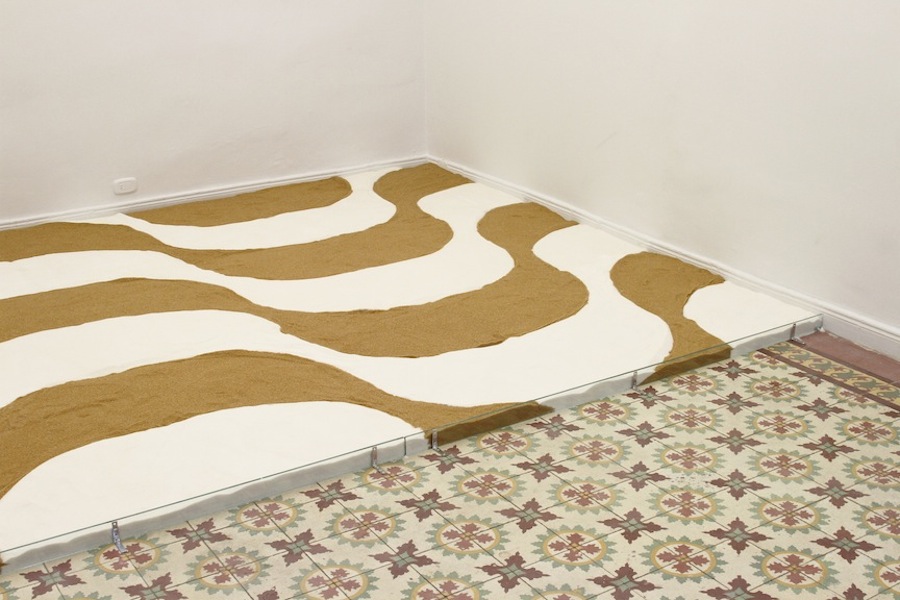Destilaciones
2014 - Sculpture (Sculpture)
Ximena Garrido Lecca
Destilaciones ( Distillations , 2014) is an installation composed of a group of ceramic pots, presented on the floor and within a steel structure. Copper pipes run through the perforated ceramics, evoking the design of an oil purifier. The work is a direct reference to the history of the Peruvian coastal town of Lobitos. The extraction of oil began in Lobitos at the start of the twentieth century, with the arrival of the British oil company Lobitos Oilfields Limited. The infrastructure built alongside the plant included a desalination plant (now defunct), a church, a casino, and a cinema (one of the first in Latin America), all now in ruins. Following a 1968 military coup, the Peruvian government initiated a program of nationalization and the oil fields fell under the control of the state. The Ministry of Defence built a military base on the adjacent land. Soon, a slow decline due to mismanagement sent the town into economic collapse, mirroring the economy nationally. Today one encounters the ruins of buildings left by the British oil company; the debris of what used to be the old military base; and the traffic of surfers that come every year in search of waves. Currently, the oil extraction is concessioned to South American Petroleum Exploration Tech (Sapet), a transnational company funded mainly with Chinese capital. There is also a major investment plan to privatize the town, proposing a transformation of Lobitos into a tourist resort. Destilaciones portrays these different waves of colonialism and the exercise of authoritarian power within the context of a developing country. By tracing economic and political cycles, the artist intends to register the residue of human activity within the landscape. Environmental and social issues are presented in relation to the modern exploitation of resources and localized ancient practices such as fishing and pottery. The three epochs of political domination that have left their mark on Lobitos—European colonialism, the nation-state autonomy, and neoliberal globalization—have all left behind remnants of their failure.
Ximena Garrido-Lecca examines the turbulent history of Peru, and specifically how neocolonial standards are transmitted through the processes of globalization. The artist approaches her works by scrutinizing urban, rural, and vernacular architecture, concentrating on spaces where a mediatory materiality is visible between the specific and the universal. Equally important is the memory of artisanal tradition and the abandonment of rural spaces as an aftereffect of the processes of modernization. Her work insinuates a permanent tension between the inheritance of vernacular culture and the new demands of industrialization, signaling the violence contained in an accelerated transnational economic model in increasingly open confrontation with the protection of the environment, sovereignty, and respect for different community lifestyles.
Colors:
Other related works, blended automatically

© » KADIST
Bani Abidi
2008The threshold in contemporary Pakistan between the security of private life and the increasingly violent and unpredictable public sphere is represented in Abidi’s 2009 series Karachi ...

© » KADIST
Bani Abidi
2012The perceived effortlessness of power, projecting above experiences of labored subordination is examined in Death at a 30 Degree Angle by Bani Abidi, which funnels this projection of image through the studio of Ram Sutar, renowned in India for his monumental statues of political figures, generally from the post-independence generation...

© » KADIST
Araya Rasdjarmrearnsook
2005The Class (2005) by Araya Rasdjarmrearnsook challenges the viewer’s personal sense of morality and tolerance by depicting a classroom from hell...

© » KADIST
Will Rogan
2007Shot in the streets of Tokyo, Collapse , is a meditation on the passing of time and on the complicated way in which we are smashed between the past and the future...

© » KADIST
Claudia Joskowicz
2008The primary interest in the trilogy is Joskowicz’s use of cinematic space, with long tracking shots that portray resistance to habitual viewing experiences of film and television...

© » KADIST
Mateo Lopez
2012With Roca Carbón (Charcoal Rock, 2012) and Roca Grafito ( Graphite Rock , 2012), López plays with our relationship to inert and unremarkable objects such as rocks...

© » KADIST
Julian Hoeber
2011Every work in Hoeber’s 2011 series Execution Changes is titled in alphanumeric code...

© » KADIST
Alessandro Balteo Yazbeck
2008Part of a larger series of photographic works, Alessandro Balteo Yazbeck’s Corrupted file from page 14 (V1) from the series La Vega, Plan Caracas No...

© » KADIST
Luisa Lambri
2002Lambri’s careful framing in Untitled (Miller House, #02) redefines our understanding of this iconic mid-century modernist building located in Palm Springs, California...

© » KADIST
Elena Damiani
2012Intersticio (Interstice) by Elena Damiani traces the topography of a non-specific site, an in-between zone...

© » KADIST
Luisa Lambri
2007Custom-built for a silent film star in 1934 in Santa Monica, the Sten-Frenke House is an idiosyncratic icon...

© » KADIST
Claudia Joskowicz
2015Some Dead Don’t Make a Sound (Hay muertos que no hacen ruido) is a single-channel video by Claudia Joskowicz that features the Mexican legend of the Weeping Woman (La Llorona) as its main protagonist...

© » KADIST
Nicolás Paris
2012Nicolas Paris studied architecture and worked as an elementary school teacher before he decided to become an artist...

© » KADIST
Joachim Koester
2007Tarantism is the name of disease which appeared in southern Italy, resulting from the bite of a spider called Tarantula...

© » KADIST
Felipe Arturo
2012Defined as entropy, the second law of thermodynamics proposes that energy is more easily dispersed than it is concentrated...

© » KADIST
Claudia Joskowicz
2009The primary interest in the trilogy is Joskowicz’s use of cinematic space, with long tracking shots that portray resistance to habitual viewing experiences of film and television...

© » KADIST
Tuan Andrew Nguyen
2012This work presents the image of an immolated monk engraved on a baseball bat...



